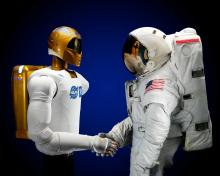On a typical space mission, astronauts are required to complete
complex tasks guided solely by training manuals or instructions from
ground control. This dynamic is known as the “mental physical
gap”—a disconnect between the mental expertise and physical
capability needed for complex tasks. As it stands, that gap can only
be closed if all astronauts are experts in all topics, or if individuals
who are experts go to space as astronauts.
At the Human Fusions Institute, we’re asking: What if ground personnel could literally lend a helping hand in space?
Using avatars, we’re paving the way for earthbound experts to physically accomplish tasks in space using our NeuroReality™ platform. Experts will neurally connect to robotic arms or robots in space, allowing them to see, hear, touch and sense everything that the robots interact with. The bidirectional haptic feedback will enable them to accomplish sensitive and highly skilled activities, all while the robots learn repetitive actions, anomaly patterns, and semi-automatic language-to-action triggers through machine learning.
This technology will save time and money while enabling more personnel to engage in activities in space without leaving the comforts of Earth. And, we will reduce risks to astronauts by enabling them to conduct experiments, do spacewalks, and fix equipment from the safety of the space station.


